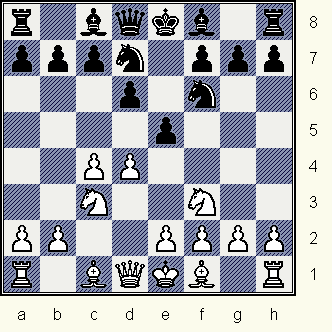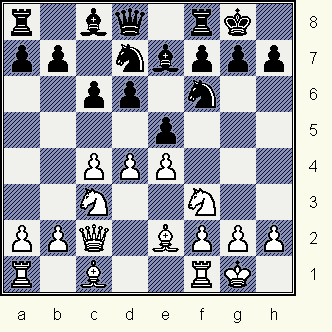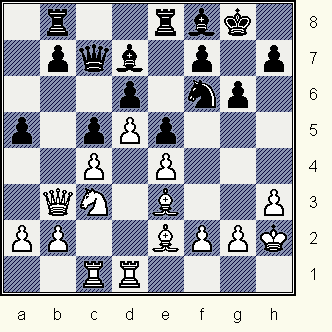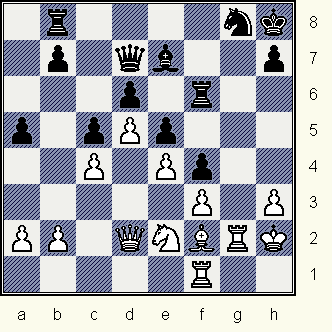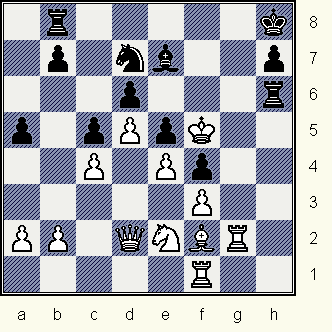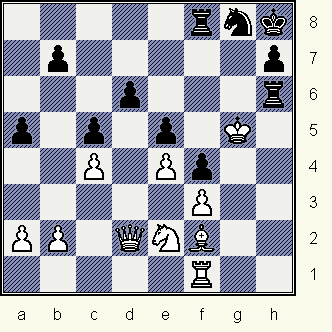All
the |
(Navigation bar
directly below.)
*******
© A.J. Goldsby, 2015.
(All rights reserved.)
****************
Click HERE
to see my
Chess Items.
****************
****************
Buy a book
from Amazon.com
(And help me out as well!)
****************
Click HERE
...
to see a list of the businesses that help to sponsor all of
my chess efforts.
Yuri Averbakh - Alexander Kotov |
|
This is one of Kotov's best known games, and it is also a very famous brilliancy. I have received literally dozens and dozens and dozens of requests to do this game. (Going back to the early to mid-1990's, when I first started creating chess web pages for the "World-wide web.") It takes time to do anything worth doing ... it takes even longer to do it right. Before I felt I could properly annotate this game, I felt I had to read just about everything ever written about this game. (I think I now have done that.) I also felt that my annotations should add or bring something new to this game ... otherwise I would be just repeating what everyone else had written. Now - thanks to good computer programs - I think I can do this as well. I also had my own opinions about this game - I wanted to see if any of these were justified. This is mostly a text-based page ... with just a few diagrams. The use of a chess board is very strongly advised. (The variations have been weeded out, to be a little less intimidating.)
Click HERE to re-play this game. (NOT my site!!!) Click here to see a fairly detailed explanation of all the symbols that I use in this game. The ratings given here are reasonably accurate ... and are the one that came with the game when I downloaded it from the CB web site. The "Chess-Metrics" web site gives the following ratings for these two players: Yuri Averbakh (2562); and Alexander Kotov (2692). (The December 31st, 1952; rating list.) |
GM
Yuri Averbakh
(2507)
- GM Alexander Kotov
(2556)
|
|
|
This
is a very famous chess game, and I wanted to at least briefly annotate it
for my websites.
(From the Candidates Tournament, in Zurich, Switzerland, 1953.)
It contains one of the most astonishing chess moves ever played, as well as one of the more famous King-Hunts of all time.
1.d4 Nf6;
2.c4 d6;
Black wants to play a type of a
King's Indian Defense ...
but the
theory of this entire system had
yet to be completely mapped out.
At this stage of development of the theory of this line, a fianchetto on move two, (...g6); was not played very much. One should also remember that this was a very important event, and Kotov obviously cannot be blamed for not wanting to play a system that was considered - at that time - to be both frivolous and dangerous for Black.
[ The modern move order is:
(>/=) 2...g6; ('!')
3.Nc3 Bg7;
4.e4 d6;
{Diagram?}
and we reach a standard position
for the King's Indian Defense.
{But it would be another 10-15
years before Masters began
using this
system on a more-or-less regular basis.}
]
3.Nf3 Nbd7; 4.Nc3 e5; {See the diagram - just below.}
*********************
*********************
This is - pretty much - a system
that masters (today) would refer
to as:
"The OLD Indian." (A
game
where this line is analyzed in
depth.)
[ Also possible is:
4...c6!?;
{Diagram?}
with a fairly playable game for
Black from this position. ]
5.e4 Be7; ('!?')
Black continues with an old-style
opening, and avoids any possibility
of the fianchetto,
(5...g6); that is
preferred by players today.
[ Black could also try:
"=" 5...c6!?; 6.Be2 Be7; 7.0-0 0-0;
8.Re1 a6; 9.Bf1, "+/="
{Diag?}
with a small but solid edge for
White in this position.
GM Hristos Banikas
(2490) -
GM Miroslav Tosic (2525);
(FIDE)
Zonal Tournament /
Panormo / Rethymnon,
Crete; 1998.
{White won a nice game.} ]
6.Be2 0-0;
7.0-0 c6; 8.Qc2!, "+/=" {See
the diagram - just diagram.}
An excellent move, although one
annotator criticized it.
(White
simply develops, prepares to
connect the Rooks, and also
keeps
almost all of his options
open. Simple, sound strategy.)
*********************
*********************
White has a very normal, solid edge out this opening - at this particular point in the game.
[ Another move would be:
8.Re1,
"+/=" {Diagram?}
which is a reasonable idea ...
and also a very popular alternative
to the text move. ]
8...Re8;
9.Rd1 Bf8;
Black has a very solid position,
if somewhat cramped and also
just a little uninspiring here.
The second player's method of
development is similar to the main
lines of the closed
Ruy Lopez ...
where Black {also} often plays
the maneuver, ...Re8; & ...Bf8.
{After the opening phase is over.}
Now b4 might have worked ...
10.Rb1!? a5!;
In a closed position - one must
pay a lot of attention to the play
on the wings. This move makes
White's idea of b2-b4 a lot more
difficult to achieve.
[ Also possible would have been:
10...exd4!?; 11.Nxd4 Nc5;
12.f3, "+/=" 12...a5;
"~" {Diag?}
with a fair position for Black.
C. Kamp - D. Loschinski; BL2 - W9192 / GER; 10,1991. ]
11.d5,
('!?')
This move has been both praised
and condemned.
("This is correct,
White gains space and fixes the
center." - Max Euwe
"This {weak}
move lets Black off rather lightly." - GM John Nunn)
My take is that it is:
# 1.) Perfectly
playable;
# 2.) And guarantees the first player
a solid edge in space.
[
Interesting was:
11.b3!?,
"+/=" {Diagram?}
with good play for White. (Nunn)
*****************************************
Another interpretation is:
(>/=) 11.dxe5!? dxe5; 12.Na4,
"+/=" {Diag?}
with a very small, but also a solid
edge for White
in this position. (The strong program - Fritz 8.0)
]
11...Nc5;
12.Be3 Qc7; 13.h3!?, (hmmmmm)
This strikes me as just a little
aimless, and also a fuzz risky.
(I prefer b3 here.)
COUNTERPOINT:
"White wisely
defends g4 ... and prevents Black
from getting too ambitious on the
King-side." - An un-named author
[ 13.a3!?, ("+/=") - CM 9000 ]
13...Bd7;
Black's position is solid, if not just
a little cramped as well. But a quick
decision does NOT seem to be in
cards at this moment.
Now one program likes dxc6! for
White. But modern programs
- while nearly
perfect at tactics
- are like small children when it
comes to questions of strategy
and long-range planning.
14.Rbc1!? g6!;
It is time to re-deploy the KB ... to a much more effective diagonal.
15.Nd2!?,
('!')
(defends e4)
"Further preparation." - GM J. Nunn
[ Or White could play:
(</=) 15.b3!?
Nh5!?; "~" {Diagram?}
- GM John Nunn
(Black has reasonable counterplay,
according to GM John Nunn.) ]
15...Rab8;
(Maybe - '!')
This is mostly a waiting move ...
that possibly prepares a later
Queen-side advance by Black.
[ Also playable was: 15...h6!? ]
16.Nb3!?,
"+/=" (Maybe - '!')
{Diag?}
A perfectly playable Knight volley;
however it was criticized by some
pundits.
I think that White keeps a
small, but permanent edge with
this very savvy
re-deployment
of his cavalry here.
White is still - very clearly - better in this position.
[
White could also play:
16.b3!? cxd5!?; 17.cxd5 b5?!;
18.a4!, "+/=" ('±')
{Diagram?}
and maintain a very solid edge.
*******************************************************
Another way for White to go
would have been:
(</=) 16.a3!? a4!?; 17.Nxa4!? Nxa4;
18.Qxa4 cxd5;
19.Qb3 d4; 20.Bg5,
"+/=" (Maybe "~") {Diagram?}
with possibly a very small edge
to White in this position. ]
16...Nxb3;
17.Qxb3 c5!;
Black locks up the Queen-side.
(This is probably the safest and
the wisest course that Black can
choose from this position.)
One writer - very foolishly - wrote
that Black ... "was now better." But
a check
with ANY good chess
program will clearly demonstrate
that this is utter nonsense.
[ Not
</= 17...Bg7?; 18.Bb6 Qc8;
19.Nb5! cxb5; 20.cxb5 Nxe4!?;
21.Rxc8 Rbxc8; 22.Bxa5,
'±' {Diagram?}
and White is close to winning. ]
18.Kh2!?,
{See the diagram ... just below.}
"A rather odd move" says Nunn,
and I agree. Nunn goes on to
point out that White
keeps a very
sizeable advantage by playing
Qc2, followed by preparing a
careful
Queen-side advance
(b2-b4) by the first player here.
*********************
*********************
Another idea is to play Qc2 followed
by Qd2 ... to dominate the dark
squares on the
King-side.
[
>/=
18.Qc2! Bg7!?; 19.Rb1,
"+/=" {Diagram?}
(White has a solid edge here.) ]
18...Kh8!?;
19.Qc2 Ng8!?; 20.Bg4 Nh6!?; (Maybe - '?!')
Black begins to prepare a King-side advance ... but I am not sure
that this is what
is required by
the position here.
<< 20...Bh6 would be a more solid
line, exchanging off his "bad" Bishop;
but then
Black would be left defending
a slightly worse position ... with no
prospects of
active play. {So} Kotov
prefers to keep his Bishop. >> - GM John Nunn
[ Maybe a little better was:
(>/=) 20...Bh6!?; 21.Bxh6 Nxh6;
22.Bxd7 Qxd7;
23.Qd2 Kg7;
"~" {Diagram?}
when repeated computer-vs.-computer tests shows that to
win the game ...
is an EXTREMELY difficult
proposition for White. ]
21.Bxd7 Qxd7;
22.Qd2 Ng8; 23.g4!?, (Probably - '?!')
A very poor idea - White thinks
he is restricting Black from ever
playing the
freeing pawn break
on the King-side. However, he
also creates weaknesses
and
targets around his own King.
*******
Nunn points out that in a position
where two sets of minor pieces have
already been
exchanged, that a
strategy of trying to keep Black
cramped or bottled up ... is much
less likely to succeed.
However ... I should point out that
White still holds a very solid edge
here ...
and this was verified by both
CM9000 and Fritz 8.0.
[ Best was:
>/= 23.Nb5!,
'±' {Diagram?}
and White keeps a fairly large
advantage in this variation. ]
Black's next move is a "live or
die" type of decision. Kotov
prefers active counterplay ...
to spending the rest of the game
passively defending his many
positional weakness.
23...f5!;
24.f3?!, (Ugh!)
This is simply horrible ... (Maybe - '?')
but Nunn does not comment on this
{very faulty} move at all.
1r2rbnk/1p1q3p/3p2p1/p1pPpp2/2P1P1P1/2N1BP1P/PP1Q3K/2RR4; B - 0 24
This move is wrong ... and also
highly illogical here.
(The first player has more space,
and also can occupy the open
g-file much more
quickly than
his opponent.) I see no reason at all
why White should be afraid to
open
the game here!
[ Correct was the continuation of:
>/= 24.gxf5,
('!') 24...gxf5; 25.exf5,
{Diagram?}
Probably the best move here.
( The move of: 25.Qd3!?, "~" {Diagram?}
probably does not lead anywhere
for White. )
25...Qxf5; 26.Rg1,
"+/=" ('±') {Diagram?}
when only the first player could
stand better from this position. ]
24...Be7;
25.Rg1!? Rf8!?; ('?!')
Possibly inaccurate ... Black should
definitely play ...f5-f4; as quickly
as possible
in this position. (And
this possibility is repeated over
the next few moves as well.)
Now the computer says that
White should definitely play
g4xf5! here.
(But White continues
to ignore this possibility.)
26.Rcf1!? Rf7!?;
27.gxf5!?,
Now White swaps the Pawns on f5,
but this is quite possibly the wrong
exchange
in this position.
[ Maybe better would have been:
(>/=) 27.exf5! gxf5;
28.f4!, "+/=" {Diagram?}
with an edge for White. - The program, Deep Junior.
]
27...gxf5;
28.Rg2?, {Diagram?}
This is definitely the wrong idea
in this position.
(Nunn gives this
extremely faulty move a whole
question mark, and so do I.)
1r4nk/1p1qbr1p/3p4/p1pPpp2/2P1P3/2N1BP1P/PP1Q2RK/5R2 B - 0 28
Nunn prefers 28.f4! for White, I like
Fritz's suggestion of exchanging
Pawns on f5,
followed by Ne4.
[ After the following moves:
>/= 28.exf5 Qxf5;
29.Ne4, "+/=" {Diagram?}
White retains a small ... but a
fairly significant ... edge. ]
28...f4!;
"Kotov pounces on Averbakh's
mistake." - Dr. John Nunn
Now according to several different
{strong} computer programs, White's
edge
has completely evaporated.
29.Bf2 Rf6!;
30.Ne2?, ('??') {See
the diagram - - - just below here.}
White hopes to bring his Knight
to the defense of his King-side ...
but this move is a virtual blunder
by White.
*********************
*********************
Nunn gives White's last move
(Ne2?) a whole question mark ...
and I am forced to agree. (Nunn
also points out that h3-h4 was
virtually forced for White.)
[ >/= 30.h4[] Rh6; 31.Qe1 Qe8; "=/+" ]
Now
it is Black's turn to play a
move in this position. What move
would you play here?
30...Qxh3+!!;
(Probably - '!!!')
Without question - an extremely
shocking reply by Black here.
(Tim Krabbe rates this as one of the
most astounding chess moves
ever played
on the chess board. http://www.xs4all.nl/~timkr/chess/mfm6170.htm)
Upon second inspection however,
one should note that it did not
require a tremendous
amount of
courage to play this move ... Black saw that he always could
force a draw
by perpetual check
from this position.
"This brilliant sacrifice introduces
one of the most exciting King-hunts
of the
Twentieth Century." - GM John Nunn
[ Also good was:
30...b5!?; "=/+"
{Diagram?}
with a small edge for Black. ]
White must capture the Queen,
it is the only legal move that is
available to Averbakh.
31.Kxh3 Rh6+;
32.Kg4 Nf6+; 33.Kf5 Nd7!?, (Really - '?')
{See
the diagram ... just below.}
A move that was praised by many,
('!!'); at least until someone pointed
out that Black
has another move ...
that virtually wins on the spot.
*********************
*********************
This is a very good place for a "look-see" ... {a diagram} ...
White's King is
stuck on a MOST unusual square here.
[
A sizeable improvement was:
>/= 33...Ng4!;
34.Nxf4, ('!')
{Diagram?}
This move is completely forced.
(
A big mistake would be:
</= 34.Rxg4???, 34...Rf8#.
** ** ** ** ** ** ** ** ** ** ** ** ** ** ** ** **
And not:
</= 34.a3?? Rg6!; {Diagram?}
and mate next move. (...Rf8#)
** ** ** ** ** ** ** ** ** ** ** ** ** ** ** ** **
Also bad would be:
</= 34.Bh4? Rf8+; 35.Bf6+ Rfxf6+; 36.Kxg4 Rfg6+;
37.Kf5 Rh5+; 38.Rg5 Rhxg5#. )
34...Rg8!!;
35.Nh5 Rhg6!;
"-/+" {Diagram?}
and Black wins easily.
(Qg5, Bxg5!) ]
White's next move is 100% forced.
34.Rg5[],
{BOX!}
{Diag?}
If White does not play this move,
he is very rapidly mated.
(For example: if the Queen
captures on a5??, then simply
34...Rf8+; 35.Kg4, Rg8+; 36.Kf5, Rf6#.)
*******
[ One very good variation ...
that clearly illustrates some of
White's difficulties would be:
</= 34.Rg7?! Rf8+;
35.Kg4 Kxg7!; 36.Nxf4, {Box!!!}
{Diag?}
This is completely forced.
***
( Nunn only gives the VASTLY
weaker continuation of:
</=
36.Rg1? Rg8; 37.Kf5+ Kf7; 38.Rxg8!? Rh5+!!; {Diag?}
A brilliant zwischenzug.
39.Kg4 Nf6#! ).
***
36...exf4; 37.Qxf4!?,
{Diagram?}
The box says that this move is
completely forced to prevent a
quick mate.
( For example: 37.Qc3+ Ne5+; 38.Qxe5+ dxe5; 39.d6!?,
39...Kf7!; 40.Bh4 Rg8+;
If now Kh3, then simply the move of ...Rxh4#.
If now Kh3, then simply the move of ...Rxh4#.
41.Kf5 Rh5+; ("-/+") {Diagram?}
and mate next move. )
37...Rg6+!; 38.Kh3 Rxf4;
"-/+" {Diagram?}
and the fact that Black is ahead
a Rook and a piece should be
more than
sufficient to win. ]
*******
34...Rf8+;
35.Kg4 Nf6+!; 36.Kf5 Ng8+!; 37.Kg4 Nf6+!?; (Really - '??')
Black cravenly chooses to repeat
moves rather than try and win the
game here.
With this cowardly play, Black forever
scars a great game and throws away
any shot at true immortality.
One could argue that Black's
method ... of repeating the moves,
and only finding
the win during the
adjournment analysis ... is the safest
and the most practical. I
would
counter that it gained Black a point,
{in the Candidates Tournament}; but
destroyed
any shot at being
enshrined in Chess's Hall of Fame!
[
Black could win instantly with:
>/= 37...Bxg5!!;
38.Qe1,
('!') {[]?}
{Diagram?}
The computer says that this is the best move here.
****************************************************
( Bad for White would be:
</= 38.Kxg5?! Rf7; 39.Bh4 Rg7+; 40.Kf5 Rhg6!;
41.Bg5 Nh6+!!; 42.Bxh6 Rf7#!
** ** ** ** ** ** ** ** ** ** ** ** ** ** ** ** ** ** **
---> Or White can try:
38.Rg1? Be7!; 39.Nxf4 Nf6+; 40.Kg5 Rg8+!; {Diag?}
Now if KxR/h6??, then Black
simply plays ...R-to-g6 mate.
41.Kf5 Ng4; 42.Nh5 Rhg6!; "-/+" {Diagram?}
Black's threats of mate force
White to give up material here. )
*****************************************************
(Returning to the main path
of our analysis line, here.)
38...Nf6+!!;
{Diagram?}
Simply brilliant.
39.Kf5,
{Diagram?}
Ugly - yet forced.
( Not </= 39.Kxg5?? Rh5#. )
39...Ng4+!!;
40.Kxg4 Rg8!;
41.Kf5 Be7;
{Diagram?}
This threatens ...Rf6# (mate) next.
42.Bh4 Bxh4;
43.Qxh4 Rxh4;
{Diagram?}
and Black has an easy win,
("-/+");
on both position and
material here. ]
38.Kf5 Nxd5+!?;
(Maybe '?!' or even '?')
"Necessary in order to avoid a
three-fold repetition of the position,
but the capture of White's d5-Pawn
actually makes the win more
complex." - GM John Nunn.
This is a truly wild position ... White
has plenty of material ... ... ...
but his King is completely cut off
from the rest of his forces.
39.Kg4 Nf6+;
40.Kf5 Ng8+;
Both sides have reached their
fortieth move.
(One side will
soon seal a move ... and play
will resume on the first free
day for both players.)
This means the game is no longer
a contest between two players, but
a challenge
to see which player's
team of seconds can do the best
job of analysis.
Kotov's team of {many} Masters
worked out the win in leisure, free
of tension and
any possibility of
a mistake. This completely destroys
any sporting value that the
remainder
of this contest might hold ...
at least it does for me!
******************************************************************
The rest of the game really does
not interest me ... see the
'Mammoth Book' for
the analysis
of the remaining portion of this
contest. (Most of White's moves
are
completely forced - to avoid
a possible checkmate.)
41.Kg4 Nf6+;
42.Kf5 Ng8+; 43.Kg4 Bxg5!;
44.Kxg5!?, {See
the diagram - just below.}
Deciding to make his opponent
'prove' the win here.
*********************
*********************
Some have criticized this as an error, but at this point, I do not think that it matters anymore.
[ Or White could try:
(>/=)
44.Qxd6 Rxd6; 45.Bxc5 Be7;
"-/+" {Diagram?}
but Black has an easy win here.
{The second player has an extra
piece - and the better position.} ]
44...Rf7;
('!')
Black now threatens ...Rg7+;
followed by a quick check-mate.
(If then Kf5, then ...Ne7 is mate.)
45.Bh4,
('!?')
Looks goofy ... but it is apparently
the only way that White can prevent
a possible check-mate here.
*******
[ Even worse would be:
</= 45.Nxf4? Rg7+!;
46.Ng6+, {Diag?}
This looks forced.
( Or 46.Kf5 Rf6#. )
46...Rgxg6+; 47.Kf5 Ne7#. ]
*******
45...Rg6+!;
46.Kh5 Rfg7;
This threatens the simple ...Rh6#.
47.Bg5!? Rxg5+;
48.Kh4 Nf6;
Now Kotov threatens ...Rh5#.
(White's next move is forced.)
49.Ng3 Rxg3;
50.Qxd6 R3g6;
This protects the Knight on f6 ... AND threatens 51...Rh6;
mate.
51.Qb8+!? Rg8; ("-/+") {Diagram?}
WHITE RESIGNS. (0-1)
(White must give up the Queen to avoid mate here.)
To some - this is an 'immortal'
game of chess, but to me it was
ruined by Kotov's
lack of courage
... and the repetition of moves.
****************************************************************
****************************************************************
BIBLIOGRAPHY:
I have seen this game in print more
times than I care to count. Possibly
one of the best
jobs of analysis is
to be found in the following volume:
[The 'Mammoth Book' Of]
"The World's Greatest Chess Games."
{100 of the greatest games of all
time, each thoroughly annotated.}
By Dr./GM John Nunn,
GM John Emms, and also by
FM Graham Burgess.
Copyright (c) 1998.
******************************************************************
(By)
Carroll & Graf Publishers, Inc. /
19 West 21st Street, Suite # 601
New York City, NY 10010-6805
(U.S.A.) / (U.K. by Robinson)
ISBN: # 0-7867-0587-6 (paper)
*****************************************************************
*****************************************************************
Copyright (c) LM A.J. Goldsby I
Copyright (c) A.J. Goldsby, 2004.
All rights reserved.
0 - 1
|
This is not the original version of this game that I worked on. {That version was easily a small book.} I lost that version of this game in one of my many computer crashes. (Actually, I may have one copy on a tape back-up. But since the manufacturer will not update that software for Windows XP/OS, I have no way of accessing it.) That copy or version of this game would have run at least thirty pages - and had very few diagrams. ******* Since I had lost all of my original analysis, I was forced to go back to "a clean sheet of paper," so to speak, for this game. When I first started working on this game, (this time around) - in March of 2004 - I only wanted to do a very quick version, something I could knock out in just a few hours. However, the more I worked on this game, the more I realized that this would not be possible. (The analysis would be very superficial, and nearly meaningless. The average player would have far too many questions ... that would have been left, for the most part, completely unanswered. And this was not really my vision for this game. I wanted something that was more worthy of this encounter.) What I {slowly} created - over a period of four-to-five months - was this version of this contest. ---> This is not my original version of this game, exactly as I created it in the original ChessBase format. What I did for this game was to annotate it in about a medium fashion. (That version of this game ran close to 25 pages ... with some deep analysis in places, and a VERY generous helping of diagrams.) Then I went back and deleted the really deep variations - and most of the diagrams - to create this version of this game. If
you have any questions about this game - please contact me. Copyright (c) LM A.J. Goldsby I Copyright (©) A.J. Goldsby, 2015. All rights reserved. ******* This page was created in July of 2004. I finished annotating this game sometime in September, 2004. The final formatting of this page was completed on: Friday; September 24th, 2004. (Around 11:30 PM.) This page was last modified or edited on: Thursday, February 26, 2015 03:07 PM . [ Home, (for this site). ] [Return (or go to) to "Annotated Games." (#1)] [Top of page.] [Return (or go to) to the "Best Games."] [Go to my personal domain.] |
